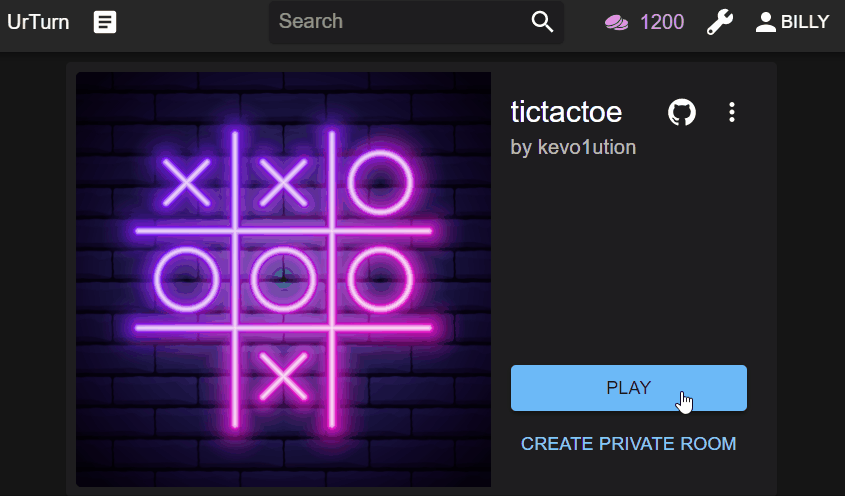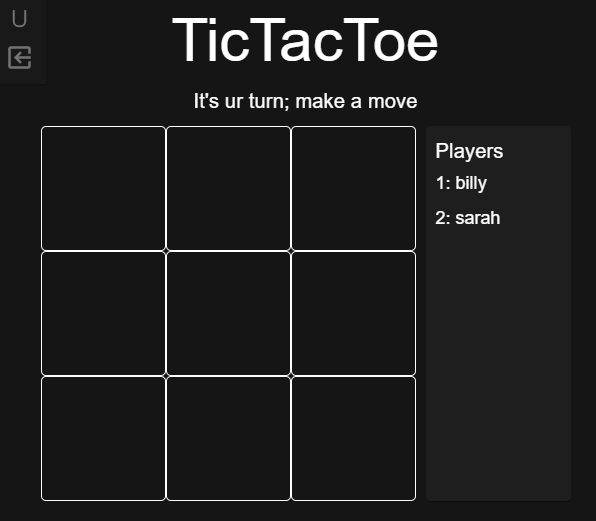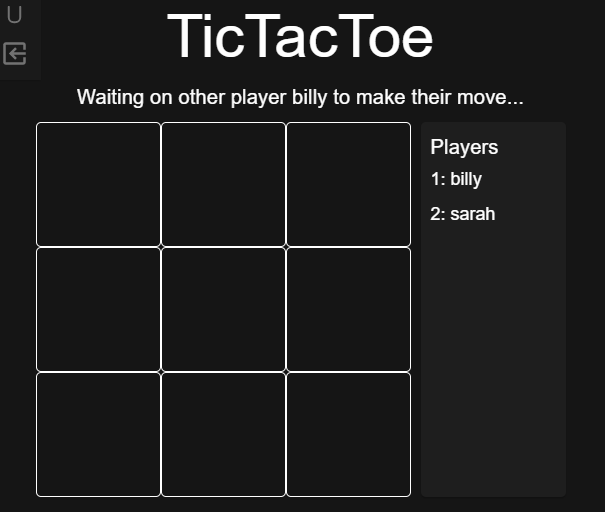Flow of a Simple Game
TicTacToe
Let's walk through a simple TicTacToe game that you made:
1. Player Billy clicks Play
UrTurn calls your room function implementation of onRoomStart to initialize the room state.
- Initial roomState
- onRoomStart code
{
"joinable": true, // defaults to true, (when set to false, UrTurn prevents any new players from joining the room)
"finished": false, // defaults to false, (when set to true, UrTurn prevents any new moves from being made)
"state": { // this field can be any JSON object that you define. This was provided in the roomStateResult by the room function above.
"status": "preGame",
"board": [
[
null,
null,
null
],
[
null,
null,
null
],
[
null,
null,
null
]
],
"winner": null,
},
"version": 0, // metadata controlled by UrTurn; as each new `RoomState` gets created, this gets incremented by 1
"players": [], // metadata controlled by UrTurn; when a player joins the room, they are added here to the list. When they quit the room, they are removed.
}
function onRoomStart() {
return {
state: {
status: Status.PreGame,
board: [
[null, null, null],
[null, null, null],
[null, null, null],
],
winner: null, // null means tie if game is finished, otherwise set to the plr that won,
},
};
}
UrTurn calls onPlayerJoin function with Billy player object and the previous roomState created earlier.
- roomState result
- onPlayerJoin Code
{
"joinable": true, // room should still let players join because there are not enough players to play tictactoe yet
"finished": false,
"state": {
"status": "preGame",
"board": [
[
null,
null,
null
],
[
null,
null,
null
],
[
null,
null,
null
]
],
"winner": null
},
"version": 1, // incremented because our room function successfully modified the state
"players": [ // new player is in the player list
{
"id": "id_0",
"username": "billy"
}
]
}
function onPlayerJoin(player, roomState) {
const { players, state } = roomState;
if (players.length === 2) { // enough players to play the game
state.status = Status.InGame;
state.plrMoveIndex = 0; // keep track of who’s turn it is
return { // return modifications we want to make to the roomState
state,
joinable: false, // we should not allow new players to join the game, tictactoe only needs two players
};
}
// our first player joined, we should do nothing (not enough players yet to start).
return {};
}
Updates are propagated to clients by sending an event to client.events.on('stateChanged') so your game frontend can update the view for the player.
2. Player Sarah clicks Play
UrTurn matchmaking system puts Sarah to the same room as Billy.
The same function onPlayerJoin is called with Sarah player object and the previous roomState, which produces the result (changes are highlighted):
{
"joinable": false, // no longer joinable as we have enough players!
"finished": false,
"state": {
"status": "inGame", // game is now in game and we can start playing!
"board": [
[
null,
null,
null
],
[
null,
null,
null
],
[
null,
null,
null
]
],
"winner": null,
"plrMoveIndex": 0
},
"version": 2,
"players": [
{
"id": "id_0",
"username": "billy"
},
{ // new player "sarah", added by UrTurn runner
"id": "id_1",
"username": "sarah"
}
]
}
Updates are propagated to all clients:
3. Billy puts X in top left corner
Your frontend calls client.makeMove({ x: 0, y: 0 }) whenever it detected billy clicking a button on the board
The client.makeMove function takes any move JSON!
UrTurn calls onPlayerMove function to handle the arbitrary move:
- roomState result
- onPlayerMove code
Resulting roomState (changes are highlighted):
{
"joinable": false,
"finished": false,
"state": {
"status": "inGame",
"board": [
[
"X", // Billy’s move!
null,
null
],
[
null,
null,
null
],
[
null,
null,
null
]
],
"winner": null,
"plrMoveIndex": 1 // next move is Sarah’s
},
"version": 3,
"players": [
{
"id": "id_0",
"username": "billy"
},
{
"id": "id_1",
"username": "sarah"
}
]
}
function onPlayerMove(player, move, roomState) {
const { state, players } = roomState;
const { board, plrMoveIndex } = state;
const { x, y } = move;
if (state.status !== Status.InGame) { // must be in the game (clients may spoof and send onPlayerMove with whatever values they want!)
throw new Error("game is not in progress, can't make move!"); // error will be propagated to the client.makeMove() call
}
if (players[plrMoveIndex].id !== player.id) { // make sure it is the player’s turn
throw new Error(`Its not this player's turn: ${player.username}`);
}
if (board[x][y] !== null) {
throw new Error(`Invalid move, someone already marked here: ${x},${y}`);
}
board[x][y] = players[0].id === player.id ? ‘X’ : ‘O’; // set the board square to the correct mark;
// game may be finished
// logic is too long to show here, but checks if an “three marks in a row” or if no more possible moves left
const [isEnd, winner] = isEndGame(board, players);
if (isEnd) {
// transitions game to end
state.status = Status.EndGame;
state.winner = winner;
return { state, finished: true }; // game is now finished, modify the "finished" metadata so UrTurn can properly catalogue this room
}
// alternate the current player move so next player can make a move
state.plrMoveIndex = plrMoveIndex === 0 ? 1 : 0;
return { state };
}
4. Room functions are pure functions
Notice how all of the implemented room functions (onRoomStart, onPlayerJoin, etc.) takes in the current roomState and several other arguments and returns a roomStateResult.
Data should feel like a natural flow of transformations throughout time:

This makes it easier to understand, debug, and test your room functions. More on pure functions.
Getting the hang of it?
You just write code for how state changes based on various room events - player joins, quits, makes move, etc.
UrTurn takes care of the rest.
Try implementing the entire TicTacToe game and deploying it to production so anyone can play it!





